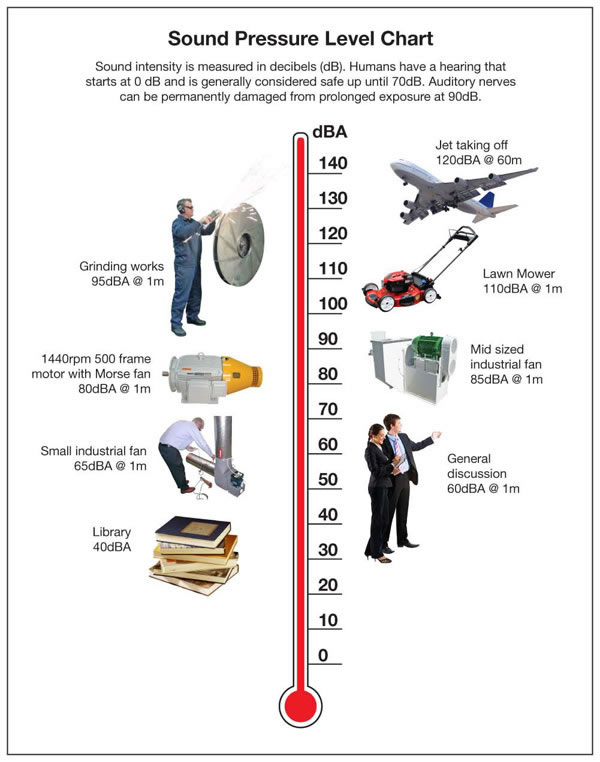Noise has a negative connotation and is best described as being 'un-wanted or objectionable sound' OK, well then what is sound.
Sound is very similar to heat - it is a form of energy that travels in waves through a medium. Sound is created when an object vibrates, resulting in very small variations in the surrounding atmospheric pressure - these variations are what is known as sound pressure.
Now as humans, our hearing covers a huge range of sound pressures, a ratio in the order of 1 to 1 million. Also our hearing responds in a logarithmic manner, and we do not detect sound pressure at very high or very low frequencies.
So since our hearing covers such a huge range and responds to stimuli logarithmically, for practical purposes sound pressure is measured logarithmically and this scale is what is referred to as decibel (or dB) - perhaps a more common logarithmic scale that we are also familiar with is the richer scale used for measuring / quantifying seismic activity.

In a everyday sense, if we take a motor and reduce the noise level by 3dBa at the higher end of the scale, say form 95-92 this will be noticeable, if we reduce it by 8-10dBa this will be effectively halving the noise.
| Change (Decibel) | Amount of Noticed Change |
|---|---|
| 1 | Generally imperceptible change |
| 3 | Barely noticeable change |
| 5 | Significant change in community |
| 10 | Subjective "doubling" or "halving" of loudness |
Now we have introduced something here - that being the 'a'. When we refer to dBa, we are talking about the a' weighted scale - this means that the sound has been filtered to reduce the strength of the high and low frequency sounds which the human ear does not detect (a dog does) If we go back to our vibrations - when the vibrations are fast, they are at a higher frequency producing a high note - when the frequency is slow, at a lower frequency, a low note is produce.
Another interesting factor about noise which relates back to the logarithmic scale is this - if you have say two electric motors, if we take the Simpson Pope 37kw 2P, and they are working away putting out their 90dBa, 2m apart and you take a reading in the middle - the combined noise level will not be 180dBa (well over the threshold of pain) but rather 93dBa.
| When Two Decibel Values differ by | Add the following Amount to the Higher Value |
|---|---|
| 0 or 1dB | 3dB |
| 2 or 3dB | 2dB |
| 4 to 9dB | 1dB |
| 10dB or more | 0dB |
So if you have a motor running at 90dBa and one adjacent to it running at 80dBa, the total noise reading will be 90dBa.
This aspect of how we measure noise was utilised on a project were a customer had measured the electric motor noise with the fan and cowl removed - it was on a 800kw 4P D450 frame and the reading was 75dba - the specification they were trying to satisfy called for 77dba no load @ 1m. Now our customer was very doubtful that we could design and build a fan and cowl that when fitted to this motor, would not exceed 77dba and yet still provide enough cooling air - however knowing this addition rule for dba, we knew our fan, when tested in isolation, need only stay under 73dba so that the difference of 2dBa be added to the 75 giving us our required limit of 77dBa
What we are highlighting here is that the whole concept of sound, sound pressure and noise is complex and is a whole discipline in itself - it would be
Unrealistic to think we can get a complete grasp of it all however it is very important. And even though it is complex, some aspect can be used to our advantage in achieving noise reductions - if we understand the fundamentals then this aids us in our design of our cooling fans.

